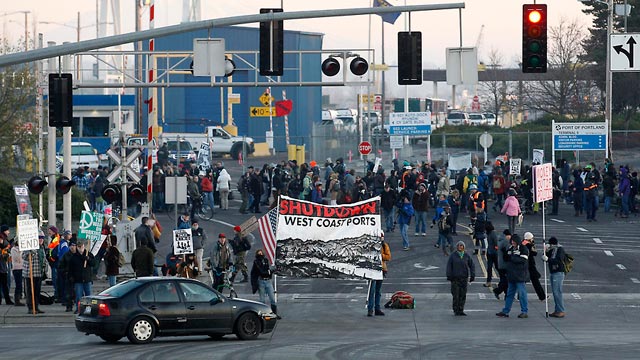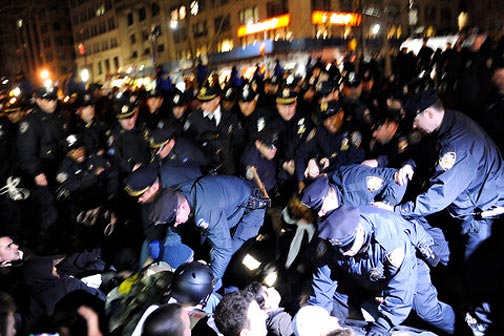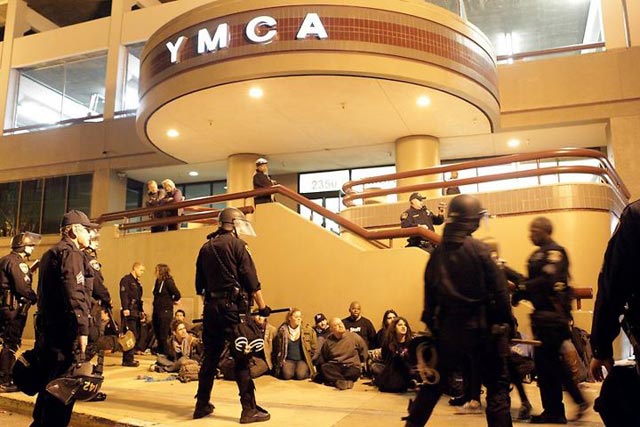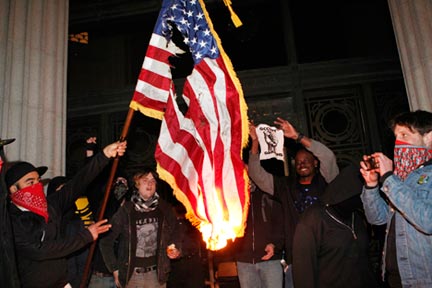The Left, Labor and Occupy
![]()
May 2012
Trotskyism vs. Social Democracy and Anarcho-Liberalism
The Left, Labor and Occupy
Occupy protesters in Portland picket Terminal 6 on December 12. (Photo: Rick Bowmer/AP)
Six months after Occupy Wall Street began – when a few hundred people sparked worldwide protest with a march and sit-in in lower Manhattan against political corruption and corporate greed – OWS was back. And four months after Occupy encampments were brutally evicted around the country, the police were there to greet them. Demonstrators chanted “this is what democracy looks like” as cops dragged scores out of Zuccotti Park in downtown Manhattan. More accurate would have been “this is what a police state looks like.” At the same time, the sharpening internal contradictions within the Occupy movement were also on display.
On March 17, OWS supporters flowed into the public-private park next door to the center of world finance capital. They were met by the New York Police Department, which once again evicted protesters with an iron fist: charging into the crowd, slamming people to the ground and arresting a French bagpipe team serenading the occupiers. Cops threw a well-known OWS activist, Cecily McMillan, to the ground, kicked her and cracked her ribs, refused to remove zip-cuffs as she began to have a seizure, and then charged her with deadly assault on a police officer. This time 73 were arrested, despite a court order allowing protesters into the square.
 NYPD wades into crowd at Zuccotti Park on March 17, arresting scores. Cops part of the “the 99%”? Police are part of the armed fist of capital. Mobilize workers’ power against racist police brutality. (Photo: Robert Stolarik for The New York Times)
NYPD wades into crowd at Zuccotti Park on March 17, arresting scores. Cops part of the “the 99%”? Police are part of the armed fist of capital. Mobilize workers’ power against racist police brutality. (Photo: Robert Stolarik for The New York Times)
Meanwhile, meeting a few blocks away was the annual Left Forum. This year’s theme was “Occupy the System: Confronting Global Capitalism.” But when 30 to 40 Occupy activists showed up at the gate, they were blocked from entering by security guards under instructions from Forum organizers, because they wouldn’t pay the outrageously high entrance fee. Rightly denouncing the “fake left,” the Occupiers marched back to Zuccotti Park, only to be busted by the NYPD a few hours later. The next day, the liberal/reformist gab fest was addressed by Chris Hedges, a Cold War anti-Communist who has denounced “black bloc” anarchists as a “cancer” and “criminal” for supposedly seeking to “hijack” and “destroy” Occupy.
Clearly, fissures have begun to show in the “99%,” in the populist vocabulary of OWS.
Only a few months ago, Occupy Wall Street was being hailed as the greatest movement since civil rights. Occupiers chanted, “We are unstoppable, another world is possible.” (What kind of other world was not specified.) At its high point last fall there were over 600 Occupy groups around the U.S., up to 1,000 by one count. They mushroomed in the space of a few weeks because OWS crystallized widespread anger over the obscene spectacle of bankers, who had triggered the worst economic crisis since the 1930s, looting billions more as mass unemployment persisted. Many saw it as a continuation of the labor upsurge in Wisconsin and the popular revolts in Egypt and Tunisia earlier in 2011.
Barely half a year later, Occupy is splintering left and right. This was inevitable in a movement that was united only in what it opposed and could never put forward a positive program, whether of reformist “demands” on the capitalist state or of revolutionary action against it. The question is: along what lines will it polarize?
OWS Splintering: The Honeymoon Is Over
When Occupy Wall Street burst on the political scene last fall, the bulk of the labor movement and many liberal Democrats embraced it after initial hesitation. Among the unions issuing statements of support and/or contributing in various ways to the Occupy movement as it spread across the U.S. were the United Federation of Teachers, Transport Workers Union, 1199 Service Employees International Union, DC 37 AFSCME, Communications Workers of America, Teamsters, International Longshore and Warehouse Union and the AFL-CIO itself.
Liberals latched onto Occupy hoping that it could pressure the Democratic Party in a more populist direction, away from the tight embrace of Wall Street financiers under presidents Bill Cllinton and particularly Barack Obama, whose campaign started with a hunk of seed money from Wall Street. Many hoped that OWS could play a role akin to the right-wing populist Tea Party in the Republican Party. Union activists, for their part, hoped that Occupy could give a shot in the arm to a labor movement that for years had appeared to be asleep at the switch.
The bulk of the left, meanwhile, sought to bury itself in the Occupy movement. In New York, OWS was started in reaction against left groups such as the Workers World Party (WWP) and its various offshoots. So others on the opportunist left such as the International Socialist Organization (ISO) were notably hush-hush about their affiliations, and told supporters of the Internationalist Group selling our paper at Zuccotti Park was “not appropriate.” Many social-democratic and Stalinist reformists tried to give the populist slogan of “99%” a veneer of class content by claiming that the 1% is a synonym for the capitalist class. On the West Coast, where Occupy groups have been more left-wing, the encampment in the renamed Oscar Grant Plaza in front of Oakland City Hall was dubbed the Oakland Commune.
The all-sided love fest (even extending to supporters of right-wing Republican Ron Paul) was extremely brief. From the outset, many OWS activists were wary of being co-opted to the Democrats, which of course was exactly what the liberals and labor leaders were after. Certainly, if anyone is trying to “hijack” Occupy, well-funded liberal operations like Moveon.org are right up there at the top of the list. And the effort to put an Occupy label on re-elect Obama efforts is continuing, in the form of outfits like “Occupy Congress” and “Occupy the Dream.” OWS protests against fundraising events for Mitt Romney call the Republican front-runner “Mr. 1%.” As if Barack Obama (2011 reported income $1.73 million) isn’t?
As the encampments in city centers persisted and multiplied last fall, the ruling class became increasingly irritated. Beginning in late October, big city mayors (overwhelmingly Democrats) launched a wave of coordinated evictions with help from Obama’s Department of Homeland Security. But what really tipped the balance was Occupy’s intervention in labor struggle. When Occupy Oakland called for a “general strike” on November 2 in response to a bloody cop eviction a week earlier, up to 40,000 people marched on the port and shut it down. Union bureaucrats and Democrats suddenly changed their tune. And when Occupy responded to the nationwide evictions later that month by vowing to do it again, the bourgeoisie went ballistic.
In the lead-up to the mid-December West Coast port blockade called by Occupy, the media were on a tear denouncing wild-eyed anarchists trying to take over respectable unions. Left-talking liberals and reformists sternly lectured would-be radicals on the danger of substitutionism. When the ports of Oakland, Portland and Seattle were effectively shut down on December 12, the backlash against Occupy militants reached a fever pitch. The ILWU president warned against cooperating with outside groups in the fight against union-busting at the new EGT grain terminal in Longview, Washington (see “Longshore Workers, Truckers: Shut the Ports, Coast to Coast!” The Internationalist supplement, January 2012).
In early January, the Obama administration announced it was ordering the U.S. Coast Guard to protect the first shipment from the EGT scab terminal. Rather than protesting this outrage, the longshore union tops ordered that there be no port shutdowns … and dispatched a couple dozen bureaucrats and hangers-on to bust up a Seattle forum called by Occupy for solidarity with the struggle in Longview. The heat was on, and soon “moderate” Occupy supporters began calling to purge radicals. Some sought to form squads of “peace police” to boot out anyone who would resist the cops. When Oakland police arrested 400+ demonstrators on January 28, the media and liberals denounced “vandalism” in City Hall by a few people protesting the mass bust.
Following the November evictions, the highly visible Occupy encampments have been replaced by a mishmash of committees, coalitions, community assemblies (Occupy the Hood/ Barrio), etc. Occupy Homes groups have mobilized to stop evictions. In some places, Occupy labor solidarity committees have aided workers in struggle. Reformist leftists operate under an Occupy label (WWP d/b/a Occupy4Jobs) or through working groups (ISO in Occupy the DOE in New York). The more militant elements have formed collectives (e.g., Hella503, Portland Action Lab and Radical Caucus of Occupy Portland) and looser “anti-capitalist” blocs. Sometimes they act in concert, sometimes not, and under the rubric of “diversity of tactics,” everyone does their own thing.
In the meantime, Occupy marches dwindle from many thousands to a few hundred protesters. There will be an uptick on May Day, though hardly a “general strike” – not even in the fantasy form some anarchists dream of. Despite the liberals’ frenzied denunciations of “disrupters,” many credit Occupy with “changing the conversation” of mainstream politics by raising issues of inequality. But even if millionaire Democrat Obama mouths some populist rhetoric – quoting “rough rider” imperialist Teddy Roosevelt! – against billionaire Republican Romney, whoever wins, Wall Street will still be running the White House. So much for “hope” and “change.”
Occupy Wall Street did bring substantial numbers of white, middle-class youth – many of them disappointed Obama voters – into protest action and acquainted them personally with state repression. As the cops pepper-sprayed and mass-arrested demonstrators, the outrageous appeals to the police as fellow 99%ers became less and less frequent. There has also been some below-the-surface resentment of the “small-time bankers” in charge of OWS funds.[1] But even the more radical activists have not broken from the bourgeois populism which is the point of political convergence of the diverse currents that make up the Occupy conglomeration (see “Expropriate Wall Street Through Socialist Revolution,” Revolution No. 9, November 2011).
The “Declaration of Occupy Wall Street” (29 September 2011), speaking as the voice of “one people, united,”[2] denounces greedy corporations and a tiny number of super-rich. Rather than a struggle of class against class, OWS presents a populist image of a united people – the “99%” – against a statistically defined tax bracket, the 1%. This populist rhetoric serves to divert protest away from struggle against the capitalist system and the ruling class as a whole. Some on the left have argued, in order to justify their opportunist policies toward OWS, that “99% and 1% can be defined in any manner desired. Marxists are free to define it as bourgeoisie and proletarian.”[3] That sort of opportunist sleight-of-hand may make it easier to sidle up to politically undefined Occupiers, but it does not help the most thoughtful among them to see their way to a revolutionary political program that gets to the root of the social ills they are reacting against.
It is necessary first of all to explain that the idea of eliminating, or even significantly curbing, the influence of money in politics while capitalism holds sway is far more “utopian” than a revolution overthrowing the production-for-profit system. But how do we get from here to there, any serious radical will ask, and what comes after? To begin with, it means breaking with the Democrats, ousting the labor bureaucrats and politically combating the misleaders who tie the black and Latino masses to the Democratic Party. It means unmasking the “NGOs” (non-governmental organizations) who act as a transmission belt for this partner party of racist American capitalism. And it requires building a revolutionary workers party against all the bourgeois parties, in order to fight for socialist revolution.
Social Democrats Look to Split Off Occupy “Moderates”

More than 400 people were arrested in Oakland, California on January 28 (above). Bourgeois media, liberals as well as social-democratic leftists complained of “vandalism” by some protesters in City Hall. ISO shamefully said burning of American flag (below) was “irresponsible” and should be “condemned.” (Photo: Beck Diefenbach/AP)
 A host of social-democratic left groups (ISO, Socialist Action, Socialist Alternative, Socialist Appeal, Socialist Organizer, Workers Action) have been assiduously courting “moderates” in the Occupy constellation. To do so, these reformists have taken up many of the battle cries of the liberals and labor bureaucrats. The ISO, in particular, scandalously excused the ILWU bureaucrats’ disruption of the Occupy Seattle labor solidarity forum[4], while the increasingly erratic centrist Spartacist League actually defended this attack on workers democracy (see “January 6: An Outrage in Seattle,” “‘Socialist’ Excuses for Disruption of Labor Solidarity Forum” and “SL’s Wrong Lessons of Longview,” Internationalist supplement, March 2012).
A host of social-democratic left groups (ISO, Socialist Action, Socialist Alternative, Socialist Appeal, Socialist Organizer, Workers Action) have been assiduously courting “moderates” in the Occupy constellation. To do so, these reformists have taken up many of the battle cries of the liberals and labor bureaucrats. The ISO, in particular, scandalously excused the ILWU bureaucrats’ disruption of the Occupy Seattle labor solidarity forum[4], while the increasingly erratic centrist Spartacist League actually defended this attack on workers democracy (see “January 6: An Outrage in Seattle,” “‘Socialist’ Excuses for Disruption of Labor Solidarity Forum” and “SL’s Wrong Lessons of Longview,” Internationalist supplement, March 2012).
A few weeks later, the ISO echoed the bourgeois press and liberals in screaming about “vandalism” by some Occupy activists. One article (“The Backlash Against Occupy Oakland,” Socialist Worker web site, 6 February) used the “v-word” five times, to describe what? Some spray-painting in City Hall and “burning an American flag while the cameras rolled.” Horrors! This was labeled “irresponsible” and something “to be condemned” (“Discussing the Way Forward for Occupy,” 8 February). The ISO also condemned demonstrators using homemade shields to ward off blows from the cops, and “in retrospect” opposed the main purpose of the January 28 demos seeking to occupy an empty building to turn it into an organizing center.
From the very outset, there have been sharp differences between the anarchist “occupy everything, demand nothing” crowd among the initiators of Occupy Wall Street and the social democrats who have repeatedly called for raising reformist demands aimed at improving the bourgeois state. The ISO complained early on about “an influential group within Occupy Wall Street that sees the occupation as prefiguring a future society – and that argues against raising any demands because that would only legitimize the existing power structure” (“A Spotlight on Wall Street Greed,” Socialist Worker, 28 September 2011). But the demands raised by the assorted social democrats in OWS do in fact call for reforming of the bourgeois state within the framework of capitalism.
In New York, a coterie of reformist groups and individuals formed a “Demands Working Group” which put forward a program of measures which amounted to a call for a “new New Deal.” (The response of the anarchist non-leaders, supposedly committed to “consensus decision-making,” was to kick this group off the OWS web site.) The program centered on a demand for “a massive, democratically-controlled public works and public service program … to create 25 million new jobs at good union wages,” to be “paid for by new taxes on the wealth and income of the rich, on financial transactions, and on corporate profits, by reinstatement of the Glass-Steagall Act,[5] as well as by ending all U.S. wars….”
This is just a slightly more left-wing version of the policies of Democrat Franklin D. Roosevelt in the 1930s. Today Obama says his jobs program will create 6 million jobs, the Demands Working Group asked for 25 million. The workers movement needs to fight for jobs for all, but the issues we face today result from a crisis of capitalism. “Demanding” the capitalist government provide more jobs no more challenges capitalism than when American Federation of Labor leader Samuel Gompers summed up what trade unions want in the word “more.” And the call to “tax the rich” (an ISO favorite) is perfectly compatible with capitalism. Not only does mega-billionaire Warren Buffet call for a 30% minimum tax rate on millionaires, Democrats and Republicans just voted a New York state budget raising taxes on the rich. So what, the top marginal tax rate under Republican Dwight Eisenhower was 91%. But “Ike” was no red.
Various anarchist and semi-anarchist groups wrongly consider the International Socialist Organization to be Trotskyist and equate its calls for “demands” with Trotsky’s Transitional Program. In reality, the ISO’s godfather Tony Cliff broke with Trotskyism in refusing to defend the Soviet Union during the post-WWII Cold War, justifying this betrayal by labeling the Stalinist-ruled USSR “state capitalist” (as does the ISO) against Trotsky’s insistence that it remained a bureaucratically degenerated workers state.
Moreover, the demands the ISO raises are calls to reform the bourgeois state. In contrast, as Trotsky wrote in 1938:
“[T]he Fourth International advances a system of transitional demands, the essence of which is contained in the fact that ever more openly and decisively they will be directed against the very bases of the bourgeois regime. The old ‘minimum program’ is superseded by the transitional program, the task of which lies in systematic mobilization of the masses for the proletarian revolution.”
–Leon Trotsky, The Death Agony of Capitalism and the Tasks of the Fourth International
The demands raised by this Transitional Program for socialist revolution are essentially calls for action by the workers movement, not the capitalist state. When Trotsky raises the demand for a sliding scale of wages and hours in order to combat mass unemployment and inflation, he is not asking the capitalist rulers to legislate a “welfare state.” He is calling on the workers to impose this in a struggle aimed at bringing down the profit system and prefiguring a socialist planned economy. Trotsky distinguishes his revolutionary call for expropriation and workers control of production from reformist calls on the government for nationalization of certain (usually bankrupt) industries or banks.
Social-democratic and Stalinist reformists call for changing budget priorities, as with their demands for “books not bombs,” “jobs not war,” etc. Trotskyists insist that imperialist wars are not a question of policy but the inevitable product of the decaying capitalist system. Against these wars it is necessary to fight to smash imperialism through socialist revolution, calling for the defeat of one’s own imperialist government rather than nebulous appeals for “peace” or simply for withdrawal from a particular war. Such appeals are the staple of the popular-front “antiwar” coalitions that all the opportunists participate in, and are intended to draw support from bourgeois sectors who want to save the capitalist rulers from their folly.
For a time, the social democrats’ bid to be a player in Occupy meant taking part in actions that were abnormally militant for this aggressively “peaceful, legal” crowd, examples being the December 12 West Coast port shutdown and the attempt by Occupy the DOE in New York to take over the mayor’s puppet Panel on Educational Policy with a “people’s mic.” But after getting nowhere with their calls for OWS to raise “demands” and in the face of growing bourgeois hostility to Occupy radicals, the ISO’s bid to recruit “moderates” out of the dwindling movement has meant shamelessly echoing the propaganda of the bourgeois liberals and pro-capitalist labor bureaucrats. This left some ISOers distinctly uncomfortable.
The main concern of the social democrats is to avoid, as the ISO put it, “further opening the gap that has begun to develop between Occupy Oakland and the wider community.” What they mean by the “wider community” is of course bourgeois “public opinion,” or at least the liberal section of it that supports the “principles” of Occupy Wall Street while opposing any actions that might call into question property rights or the functioning of the (capitalist) economy. These days, the ISO and Socialist Alternative (SAlt) are mainly exercised to oppose calls for strike action on May 1 while vituperating against the “the danger of ultra-leftism” in Occupy. (SAlt also denounced the supposed “vandalism” in Oakland City Hall.)
“Ultra-leftism” is the big problem facing the left in the U.S. today?! What country are they living in? Obviously the ISO, SAlt et al. are worried that new layers of youth may be attracted to something more militant than the insipid reformism they peddle. But this also shows a fundamental misreading of the politics of the supposed radicals they are railing against. Even the more tactically militant sections of Occupy are politically populist, appealing to “the people united,” rather than working-class struggle. While social democrats may recoil at clashes with the cops, fearing it will cost them in “public opinion,” certain anarchist sectors revel in street battles – in good part because they think that media coverage of cops bashing protesters will gain them sympathy. With different tactics, both are playing for support from the liberals.
So now we have the 2012 U.S. election campaigns running full blast. Despite Occupy complaints, money will play a bigger role than ever in deciding who will by president, with Democrat Obama aiming to spend over $1 billion, while the Republican Romney is shooting for $800 million, plus untold millions from corporate “Super PAC” political action groups. At this point in the normal election cycle, the reformists would be promoting some minor bourgeois “third party” or politician, such as the Greens or Ralph Nader (backed by the ISO in 2000 and 2004, begged by SAlt to run in 2008) or sidling up to the Democrat (as ISO did with Obama in 2008, repeating his “yes we can” slogans).
However, this time around they are pretty much blocked. Some hoped for an Occupy candidate, but the political heterogeneity of the movement has ruled that out. While unable to tail shamelessly after Obama as imperialist commander in chief because of anger over his blatantly right-wing policies in office, the ISO also doesn’t want to be held responsible for siphoning off potential Democratic votes to make possible a Republican victory (as Nader was in 2000). SAlt, meanwhile, produced a truly tortured election perspectives document saying that while a workers party would be nice, they would support a left populist (capitalist) candidate, except they still can’t find a “dynamic contender” (“Socialists and the 2012 Elections,” 25 March).
So despite their ingrained electoral opportunism, all the social democrats have on offer this time around is “systematic and patient organizing” for “struggles – large and small” (ISO). A handful of left groups (SPUSA, PSL, SEP, FSP) are ritually running their own candidates, on indistinguishable reformist programs. This is hardly appealing to youth who thought they were taking to the streets to fight Wall Street. And, while the pseudo-socialists may denounce Goldman Sachs and even timidly criticize Obama, they do not call, as the Internationalist Group does, for a fight for the political independence of the working class from all capitalist parties and politicians, and to build a revolutionary workers party that can overthrow capital.
[continued... see comments]
Get Involved
If you'd like to help with maintaining or developing the website, contact us.
Publish
Publish your stories and upcoming events on Indybay.


